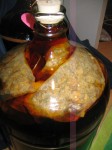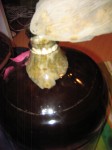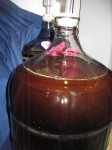Dry Hopping the Seirra Pale Ale
When I ordered my Sierra Pale Ale clone kit, I knew right away that I wanted to dry hop it. I have always liked the Sierra Pale Ale but thought it lacked a bit in the aroma department. To try and get that flowery, hoppy aroma from a beer I love, I decided to dry hop. Dry Hopping is the technique of adding aroma hops after the wort has cooled and the beer has finished fermenting. Since the kit used Cascade hops as the aroma hops in the boil, I decided they would be the appropriate complement to use in my dry hop experiment.
For this beer, I added an ounce of Whole Cascade hops when I transferred to the Secondary. I sanitized a nylon fine mesh bag, added the hops. If you are not familiar with whole hops, they take up quite a bit more volume then hop pellets. Volume, the
space some thing takes up, well I should have been paying attention to that simple, yet very important physics concept. My secondary fermentor is a 5 gallon glass carboy, it has a finite volume that holds 5 gallons of beer. So, I add about 3/4 of the beer from the primary into the secondary, stop it and proceed to stuff the bag of hops into the fermentor. Before the whole bag goes into the secondary I take a sanitized string, tie off the top and push it the rest of the way in. Be sure to leave the end of the string out of the carboy, so you can pull out the bag of hops when the beer is done dry hopping.
I now have a 3/4 full carboy with an ounce of hops in a bag sitting on top; time to fill up the rest of the rest of the secondary with the remainder from the primary. I turn back on the spigot to finish the transfer, and I walk away for a minute to do something and when I get back the carboy is literally filled. The level of beer in the carboy was exactly even with the top. How it didn’t over flow I don’t know.
I quickly got a turkey baster, sanitized it, and started to suck out the beer. You need to have some space between the top of the beer and the airlock. I ended up sucking out about 16oz of beer to get that space back. Luckily, I only made a little bit of a mess.
I left the hops in the secondary for 11 days. One thing you will find if you do this, it is much easier to get them out then to get them in. However when you pull them out, you will create a cloud of microscopic hop pieces. All you have to do is let the beer settle for another week and it will clear up.
Now I just have to wait and taste how this beer comes out. I should know in March.






Recent Comments